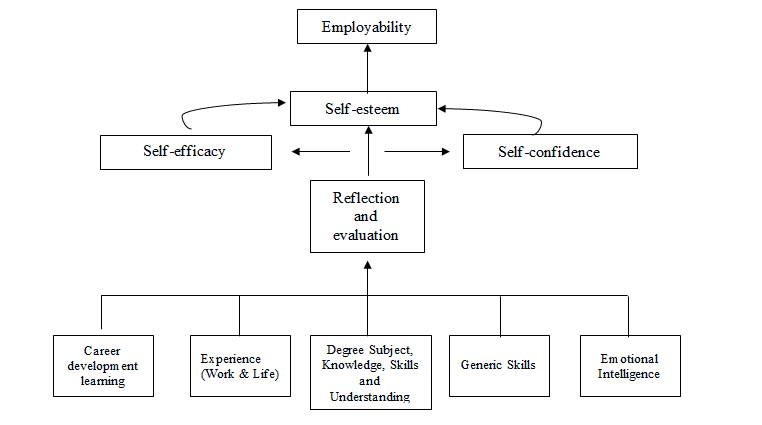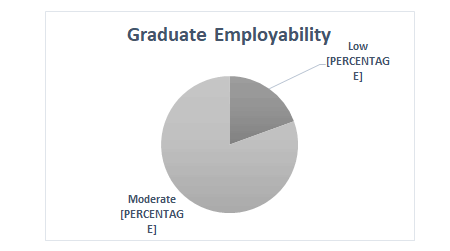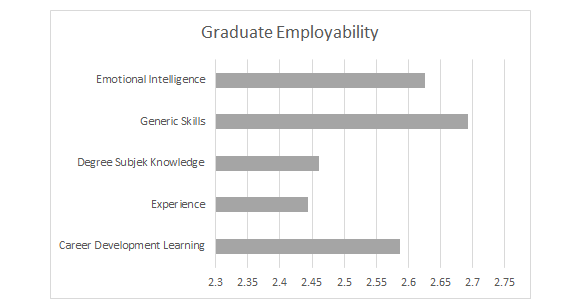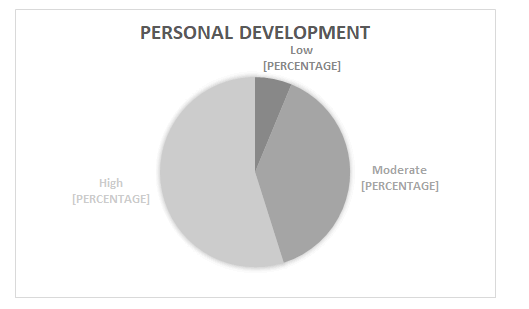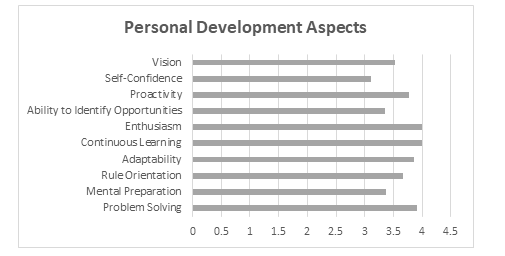Research Article: 2021 Vol: 24 Issue: 1S
Predicting Graduate Employability through Personal Development Training in Digitalization Context Association of Industrial & Organizational Psychology (APIO) West Java
Arief Budiarto, Universitas Jenderal Ahmad Yani
Gianti Gunawan, Universitas Kristen Maranatha
Anissa L. Kadiyono, Universitas Padjadjaran
Endah Andriani, Universitas Jenderal Ahmad Yani
Abstract
Having high employability has become students’ goal to achieve after graduating from university. However, having employability requires preparation, not only for the degree obtained but also the skills, abilities, competencies, and mental attitudes required to work in industries. A competitive labor market, illustrated as the imbalance between the number of graduates and the number of job vacancies available in industries, has become a problem for university graduates and resulted in the high unemployment rate in Indonesia. As prospective graduates, students provided with training to be more aware of themselves and to develop their potential is a method to improve their mental attitudes in having themselves prepared to enter the labor market. Digital personal development training can be implemented to enhance students’ employability specifically in the midst of the COVID-19 pandemic situation which limits physical meetings. The result showed that personal development training had a significant influence on enhancing students’ employability. However, it requires further improvement especially to digitally increase students’ job competencies in order to produce fully prepared university graduates to enter the labor market.
Keywords
Personal Development, Employability, Training, Digitalization, University Students
Introduction
The current labor market in the industry 4.0 has been even more competitive. This results in a greater competition for human resources to get employed in order to be able to survive. Additionally, human resources are expected to be more aggressive to compete with one another. The competition commonly occurs through human learning in both formal and informal education. Formal education started from elementary school to university is a means to gain knowledge and abilities to be applied at the workplace. University students are frequently considered as the final level in formal education, which generally becomes the qualification for a job. Hence, students are expected to have employability to be able to compete when entering the labor market.
According to Yorke (2006), employability is defined as a set of achievements, skills, understandings, and personal attributes that make graduates more likely to gain employment and be successful in their chosen occupations that will benefit themselves, the workforce, the community, and the economy. Students’ employability is a significant aspect to take into real consideration by universities in carrying out teaching and learning activities. However, students perceive that they are not yet fully prepared and that they need more improvement regarding their employability. As related institution in this regard, universities are responsible to implement intervention in order to enhance students’ employability through personal development training. Employability theory used in this study was CareerEDGE model referred to the Employability Development Profile (Pool, Qualter & Sewell, 2014) (Figure 1).
Based on Figure 1, employability development consisted of several components; including career development learning, work experience and life experience, degree subject, knowledge, skills, and understanding, generic skills, and emotional intelligence. The model reflects the statement that each component is absolute and important, in which one missing element will greatly reduce graduate employability (Pool, Qualter & Sewell, 2014). Referring to the Career EDGE model of graduate employability, universities are expected to improve the components and to provide them in the curriculum offered. Thus, by the time students have graduated, they will be able to have the ability and competitiveness to enter the labor market.
Training can be implemented as a method to enhance students’ employability. According to Widodo (2015), training is a series of individual activities to systematically improve skills and knowledge in order to be able to have professional performance in their specific expertise. The training intends to improve both hard competencies and soft competencies required by students to enter the labor market. Hard competency is related to the functional or technical ability for work. Soft competency is related to the ability to manage work processes (Jufrizen et al., 2014).
Based on a research conducted by Gegenfurtner et al., (2020) digital technology is essential for training, adult education, and human resource development in many organizations. Increasing technology-mediated training in number provides flexible, pervasive, and on-demand access to learning materials. For instance, individuals are able to develop their knowledge and skills in learning management systems, webinars, or through digital video-based scenarios. Students will enter the labor market with various competencies and abilities required to maintain their work. In university, it is possible to provide students with basic training as a competitive advantage for them to be employed for job that suits their interests. Provided with the training, students are expected to have self-understanding about their capacities. By the time students have understood their own capacities, they will be able to choose which personal development they require the most to enter the labor market.
The self-awareness performed by students is related to a theory called Johari Window. The Johari window is a model for self-awareness, personal development, group development, and understanding relationship (Luth et al., 1950). The Johari window focuses on individuals’ knowledge of themselves through two dimensions (self and others) and two values (known and unknown). The Johari window raises awareness about universities’ understanding about their students in order to support students’ abilities and development (Table 1).
| Table 1 The Johari Window |
||
|---|---|---|
| Known to self | Not known to self | |
| Known to others | Open Area (Arena) | Blind spot |
| Not known to others | Hidden (Façade) | Unknown |
The training implemented in this study seeks to improve the ‘known to self’, specifically in the open areas or known as arena. According to Koca (2019), the open area refers to how individuals identify their own emotions and ideas, and how others would be able to recognize that. Being aware of themselves can make students identify the extent of their knowledge and abilities, and which aspect that requires improvement the most. Based on Lowes (2020), open areas can be improved by providing knowledge through modules, teaching and learning processes. Hence the training is necessary to improve students’ ability to be more competitive in the labor market. Digital training must emphasize the provision of skills and competencies required by students to enter the labor market.
Methods
Data in this study was obtained using convenience sampling method. Convenience sampling is a collection of information from sample, taken from population members who are easy to reach and able to provide information either by accident or unintentional meeting. Convenience sampling is a non-probability sampling method. The population in this study was 98 undergraduate students in Bandung city, Indonesia. The data was collected online. The instrument used in this study was a questionnaire consisted of five components of graduate employability based on the Model of Graduate Employability.
Results
Data obtained from the respondents was then processed statistically to examine a more detailed picture of graduate employability and personal development training. The graduate employability is illustrated as follows (Figure 2):
Based on the data processing performed, it was found that the graduate employability was moderately high. A total of 81% out of 98 students participated was in a moderate category and 19% was categorized as low. In other words, students were quite prepared to enter the labor market in the future (Figure 3).
Specifically, generic skills component had the highest score. It refers to basic skills that can support students in any discipline and potentially be used in various contexts such as at the workplace (Bennett et al., 1999). The high generic skills perceived by students indicate that students believe that they have the knowledge and abilities obtained from the learning process to be used when pursuing the job they aspire to have in the future.
The other four components fell into a low category. The first component is emotional intelligence. According to Goleman (2001), emotional intelligence is the ability to recognize our own feelings and the feelings of others, the ability to motivate oneself, and the ability to manage emotions well in the context of relationship with others. In terms of emotional intelligence, students perceive that their ability to recognize their feelings and the feelings of others requires improvement. This is especially important because it will influence their work productivity. The second component is career development learning. Students believe that there is a lack of information about career development which causes them to be unable to determine their career goals, and instead only concerned about being able to work productively. The degree subject knowledge component had a low score as well. It refers to the quality of the lecturers in understanding the courses provided to students. In other words, the low subject knowledge score illustrates that students perceive that the lecturers are less able to facilitate them in understanding the courses taken. The final component is experience. It refers to the opportunity provided by the university to facilitate students to have proper experiences before entering the labor market. The low experience score illustrates that the university does not provide proper facilities and opportunities for students to be able to gain more experiences before graduating, specifically experiences related to the job they aspire to have (Figure 4).
In addition to employability, this study also examined the personal development experienced by students. Based on the data processing performed, it was found that the majority of students had high personal development (55%). A total of 39% students had moderate personal development and the remaining 6% had low personal development. The great number of students with high personal development indicates that the majority of students have a great self-awareness, in which they are able to identify their abilities and knowledge. This indicates that they have a deep understanding of themselves, and are able to identify what they have already had and what are necessary to improve (Figure 5).
Furthermore, personal development experienced by students is possible to be improved by personal development training which includes the ability for continuous learning, maintaining the energy to move forward, the adaptive ability in dealing with different circumstances, and the ability to solve problems as they arise. The ability to be proactive in any circumstance and to comply with rules is also necessary for personal development at the workplace. The prioritized aspects that require to be improved by students are building their confidence in any circumstance and identifying opportunities in order to be productive in accordance with the available opportunities.
Personal development is essential as it allows students to have tactical and strategic thinking for personal and professional development, such as achieving career goals, increasing self-strengths, developing career, etc. Personal development possibly occurs by participating in training, learning from people around, and improving their own abilities. Therefore, personal development is as essential as enhancing students’ employability to enter the labor market in the future.
Result of the correlation test performed showed that graduate employability is correlated to personal development training implemented by universities. Thus, the training is indeed beneficial in enhancing students’ employability (Table 2).
| Table 2 Correlations |
||||
|---|---|---|---|---|
| TotGE | TotTPD | |||
| Spearman's rho | TotGE | Correlation Coefficient | 1 | 0.249** |
| Sig. (2-tailed) | . | 0.003 | ||
| N | 144 | 144 | ||
| TotTPD | Correlation Coefficient | 0.249** | 1 | |
| Sig. (2-tailed) | 0.003 | . | ||
| N | 144 | 144 | ||
The correlation coefficient (r) between the two variables was 0.249. According to Guilford Correlation Criteria (1956), the coefficient indicates that there is a low correlation. Magnitude of the determination between personal development training and graduate employability was examined by the following formula.

Based on the above formula, personal development training contributes 6.2% to students’ employability, and the remaining 93.8% is influenced by other factors not examined in this study. Students’ employability was assessed through five components, including emotional intelligence, generic skills, degree subject knowledge, experience, and career development learning. The five components require be further developing and providing by the university in order that students will be fully prepared when entering the labor market.
Personal development includes the ability that helps individuals to develop personally and professionally. Improving personal development will help reach students’ potential. Hence, training for personal development is predicted to enhance students’ employability.
Conclusion
The digital personal development training might be an alternative to enhance students' employability in entering the labor market. Personal development training contributes 6.2% to students’ employability, while the remaining 93.8% is influenced by other factors. In spite of the low level of contribution, this digital program is possible to be implemented as a method to increase students' personal competencies required in order to enhance their employability when entering the labor market. Students’ employability falls into high category which indicates that students will be prepared to enter the labor market by the time they have graduated. Meanwhile, the overall personal development experienced by students is relatively low, meaning universities are expected to take this into consideration in order that students will be able to develop themselves further.
References
- Yorke, M., & Knight, P. (2006). Embedding employability into the curriculum: Learning and employability series one. New York: Higher Education Academy.
- Pool, L.D., Qualter, P., & Sewell, P.J. (2014). Exploring the factor structure of the CareerEDGE employability development profile, 56(4), 303–313.
- Suparno, E.W. (2015). Human Resource Development Management. Yogyakarta: Pustaka Pelajar.
- Jufrizen, R.P. (2014). Soft Competency: Efforts to increase the company's competitive advantage in the era of global competition (Rbv Approach). Journal of Accounting Research, 14(1).
- Koca, G.S., & Erigus G., (2019). The effect of communication skills level of health professionals on the dimensions of the Johari window model. International Journal of Healthcare Management.
- Lowes, R. (2020). Knowing you: Personal tutoring, learning analytics and the Johari window. Frontiers in Education, 5.
- Sugiyono. (2012). Qualitative quantitative research methods and R&B. Bandung: Alphabeta.
- Ann, P., Jeff, W., Hendy-Isaac, S., & Ruth, L. (2012). Pedagogy for employability. York, UK: Higher Education Academy.
- Arshad, M.A., Khan, K., Khan, S., & Shahid, Z. (2020) High performance organization: The only way to sustain public sector organisations. International Journal of Public Sector Performance Management.
- Goleman, D., Boyatzis, R., & McKee, A. (2001). Primal leadership: The hidden driver of great performance. Harvard Business Review, 79(11), 42-51.
- Paul, J. (2008). Convenience sampling. Ensyclopedia of Survey Research Methods.
- Andreas, G., Schmidt-Hertha, B., & Paul, L. (2020). Digital technologies in training and adult education. International Journal of Training and Development.
